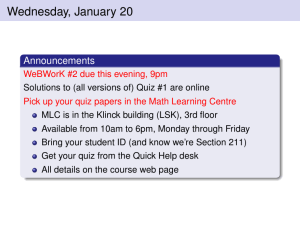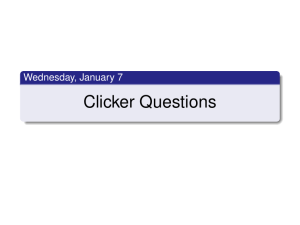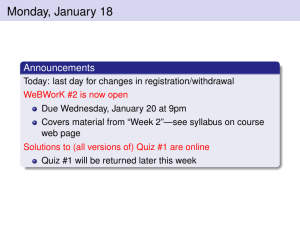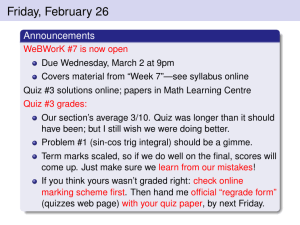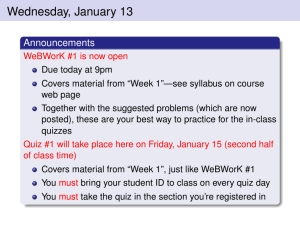LEP
advertisement
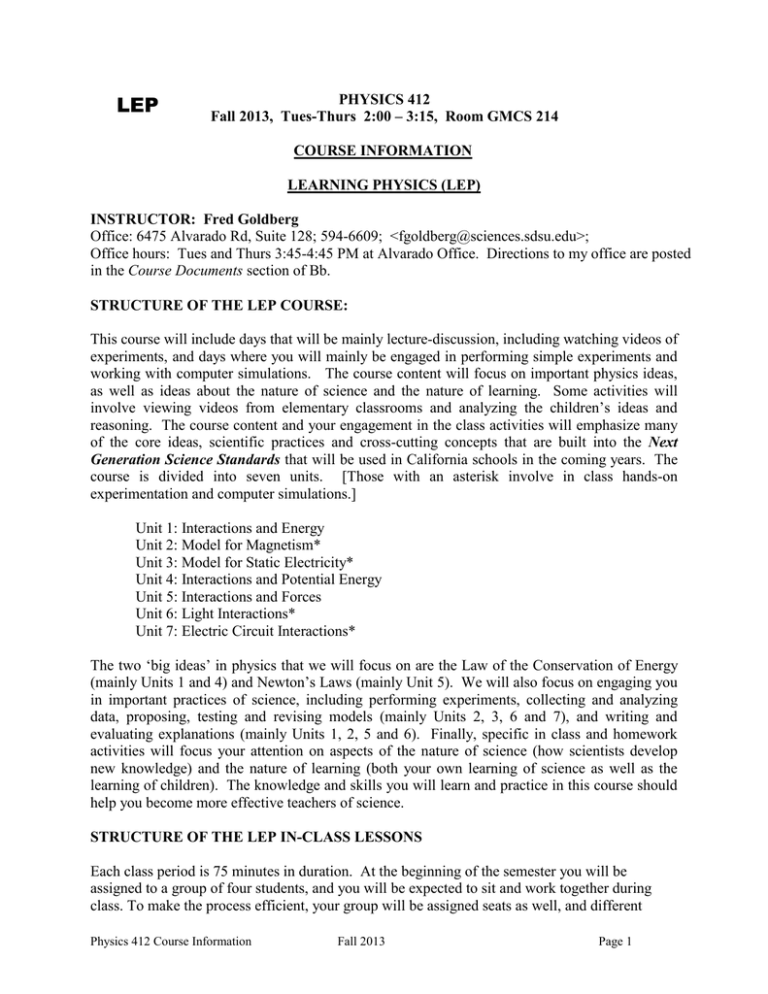
LEP PHYSICS 412 Fall 2013, Tues-Thurs 2:00 – 3:15, Room GMCS 214 COURSE INFORMATION LEARNING PHYSICS (LEP) INSTRUCTOR: Fred Goldberg Office: 6475 Alvarado Rd, Suite 128; 594-6609; <fgoldberg@sciences.sdsu.edu>; Office hours: Tues and Thurs 3:45-4:45 PM at Alvarado Office. Directions to my office are posted in the Course Documents section of Bb. STRUCTURE OF THE LEP COURSE: This course will include days that will be mainly lecture-discussion, including watching videos of experiments, and days where you will mainly be engaged in performing simple experiments and working with computer simulations. The course content will focus on important physics ideas, as well as ideas about the nature of science and the nature of learning. Some activities will involve viewing videos from elementary classrooms and analyzing the children’s ideas and reasoning. The course content and your engagement in the class activities will emphasize many of the core ideas, scientific practices and cross-cutting concepts that are built into the Next Generation Science Standards that will be used in California schools in the coming years. The course is divided into seven units. [Those with an asterisk involve in class hands-on experimentation and computer simulations.] Unit 1: Interactions and Energy Unit 2: Model for Magnetism* Unit 3: Model for Static Electricity* Unit 4: Interactions and Potential Energy Unit 5: Interactions and Forces Unit 6: Light Interactions* Unit 7: Electric Circuit Interactions* The two ‘big ideas’ in physics that we will focus on are the Law of the Conservation of Energy (mainly Units 1 and 4) and Newton’s Laws (mainly Unit 5). We will also focus on engaging you in important practices of science, including performing experiments, collecting and analyzing data, proposing, testing and revising models (mainly Units 2, 3, 6 and 7), and writing and evaluating explanations (mainly Units 1, 2, 5 and 6). Finally, specific in class and homework activities will focus your attention on aspects of the nature of science (how scientists develop new knowledge) and the nature of learning (both your own learning of science as well as the learning of children). The knowledge and skills you will learn and practice in this course should help you become more effective teachers of science. STRUCTURE OF THE LEP IN-CLASS LESSONS Each class period is 75 minutes in duration. At the beginning of the semester you will be assigned to a group of four students, and you will be expected to sit and work together during class. To make the process efficient, your group will be assigned seats as well, and different Physics 412 Course Information Fall 2013 Page 1 group members will be asked to take on some specific management responsibilities. The instructor may call on your team at any time to share answers to questions with the whole class. During the semester we will change groups and/or reassign seating of groups within the classroom. During the portions of the course that are mainly lecture-discussion (Units 1, 4, 5 and parts of 3), you will work through two different lessons each class period, guided by the instructor. Each lesson consists of three sections with different aims. Purpose This provides a short introduction describing the aims of the lesson and how it ties in to the topic. It also poses the key question(s) for the lesson. Predictions, Observations and Making Sense This is the main section of the lesson. Here is where you will record your answers to questions in the lesson sheets (including some questions that you respond to with your clicker), record data and describe your observations from videos of demonstrations or computer simulations, summarize your interpretations of why you think certain things happen, and take notes from class discussions. Summarizing Questions In the last part of a lesson you will answer questions that draw on the ideas developed during the lesson, including some that may be clicker questions. The last question will ask you to reflect on the key question(s) for the lesson; because of time constraints you should plan on answering this question at home as a review of the lesson. During the portions of the course that are mainly hands-on (Units 2, 3, 6 and parts of 7), your group will be given some materials and you will spend most of the class time carrying out simple experiments, recording and analyzing data, and sharing your results with the rest of the class. Two members of your group will also need to bring a laptop computer, and your group will spend part of the class time working with special computer simulations that will be related to the experiments you do. The instructor will provide some guidance during these periods, will occasionally show videos of experiments that are difficult to do during class, and will organize whole class discussions of results. REQUIRED COURSE MATERIALS: The required course materials are available (only) at the SDSU Bookstore under the Physics 412 course and my name, and consist of a set of worksheets that you will complete during class. The ‘text’ is called “Learning Physics (LEP) Spring 20213” and the authors are Fred Goldberg, Steve Robinson, Ed Price, Danielle Boyd Harlow and Michael McKean. The complete set of materials for the semester is three-hole punched and shrink wrapped. You should also obtain a three-ring binder and plan on bringing one unit’s worth of materials to class each day. You will be expected to bring the first lesson of Unit 1 to class on the first day. All homework and other special handouts will also be available online in Blackboard. We will use a classroom response system (aka clickers) in our course, specifically i>Clicker2. Clickers are small handheld devices used to foster interaction, active learning, and quick Physics 412 Course Information Fall 2013 Page 2 feedback for faculty and students. You are required to obtain a clicker as a learning resource (just like a required text). You must purchase and register your clicker no later than the second class meeting (January 22), and you must bring your clicker to class on that day prepared to participate. [However, it would be best for you to bring your registered clicker to class on the first day (January 17) so we can practice using it.] You will need to register your clicker via Blackboard for our Physics 412 section. More information on the registration process for your clicker can be found by going to http://clicker.sdsu.edu. Students may not use other students' clickers; doing so is a violation of academic integrity, and you may loose all clicker participation points for the semester as a consequence. PARTICIPATION POINTS As mentioned above you are expected to bring your clicker to class each day and participate by answering the clicker questions. Beginning with the second-class session of the semester (January 22), and each class session thereafter (except January 24 when Phoebe Roeder will teach the class in my absence), you will receive 1 participation point for using your clicker during class for each class period, up to a maximum of 26 points. [So, even though there will be as many as 28 days where you should use your clickers, you will only receive credit for up to 26 days. This way you can miss up to 2 days of clicker use without any penalty—which should take care of absences, clickers not working, coming to class without your clicker, etc.] To receive your 1-point participation credit for a given day you must respond to at least 75% of the clicker questions asked that day. [Clicker questions will not be graded; you receive your credit just for participating.] To be fair to all students, if you did not use your clicker during class, either because you forgot to bring it or you did not attend class, then your participation score will be 0 for that day—even if you are physically present in class. I want to emphasize that you are not permitted to have someone else use your clicker for you. You must be present with your own working clicker to receive credit. If you attend class without your clicker, then you will not receive participation credit for that day. If you do not attend class and someone else uses your clicker on your behalf, then that is academic dishonesty, and it is also unfair to other students in the class. If that happens you will lose all participation points for the semester (i.e., you will receive 0 total participation points). STRUCTURE OF THE LEPS HOMEWORK ACTIVITIES There will be two types of homework assignments. One type will be associated with most inclass lessons and will be due no later than the class period following the one at which it is assigned. In doing the homework, you are free to work with other students, but you must submit the homework results individually (see below). The other type will involve writing and evaluating explanations and will take about 1½ weeks to complete. For this latter type you must work individually. Most in-class lessons have online homework associated with them (the first type mentioned above). The homework can be accessed from our Blackboard course site, in the Assignments section. We will work through two different lessons in a typical class period during Units 1, 4 and 5, and that means you will usually have two different homework assignments to do for each class period on average (a few times less and a few times more). During Units 2, 3, 6 and 7 you Physics 412 Course Information Fall 2013 Page 3 will work through one extended lesson during each class period and will usually have a single homework associated with that; those homework assignments are included in your course materials. For each homework assignment during Units 1, 4 and 5 there are two separate documents on Bb. In the first document (labeled HW) you will be guided through some material to read, some movies or computer simulations to view, and a series of questions to answer. You will receive feedback on your answers, but during this part of the homework they will not be graded. You will receive 2 homework points just for working through this part of the homework (see below for how to receive these points). The second part of each homework assignment is a quiz, and is available in a separate document on Bb (usually labeled “HW Quiz”). In the quiz document you will be asked a few questions (usually between 2 and 5) relevant to the content of the homework, and your answers will be graded and reported to the instructor via the Blackboard grade book. When answering the quiz questions in the second document, you should keep the first HW document open in a separate window. (The first document also contains the same quiz questions with appropriate graphics included, but you cannot answer the questions while in the first document. The second document includes the same questions, but does not always include the graphics—which is why you want both documents open at the same time.) The maximum you can receive for correctly answering the quiz questions is 10 points, assuming you answer all questions correctly. The last quiz question will ask if you want to receive 2 points for just going through the first homework document, and you should always answer ‘yes.’ Thus, the total points you receive for a given homework assignment will be between 2 and 12, depending on what fraction of the quiz questions you answered correctly. For the homework in Units 2, 3, 6 and 7, you complete it at home by filling in the worksheets. There is also an online quiz associated with each of those homeworks, just like the online quizzes for homework during Units 1 and 3. To receive credit for homework, you must complete all the homework assigned in class before the beginning of the following class period. So, if HW is assigned on a Tuesday, you must complete it before 2:00 PM the following Thursday. If HW is assigned on a Thursday, you must complete it before 2:00 PM the following Tuesday. After 2:00 PM, you will no longer have access to the assigned homework quizzes. You can still read through the homework document, but cannot submit your answers to the quiz questions and cannot receive any homework credit. At the end of the semester your semester HW score for all these regular types of homework assignments, plus two online surveys, (which will total approximately 480 points) will be normalized to 75 points. So, if you receive 85% of all the possible HW points during the semester, your semester HW score would be 85% of 75 = 63.8 points. Five times during the semester you will be given a writing/evaluation assignment where you will be expected to construct an explanation or provide answers to a set of questions. Three other students in the class will evaluate your explanation, you will evaluate the explanations of three other students (all anonymously), and you will do a self-evaluation of your own explanation. After submitting your own explanation, but before evaluating other students’ explanations, you will practice evaluating some sample ‘calibration’ explanations. You will be working on each of these types of homework assignments for about 1½ weeks. The online system we will use to do this is called Calibrated Peer Review (or CPR). The first CPR assignment will be worth up to 3 points, and each of the following four CPR assignments will be worth 6 points each. Thus, the semester total score for CPR assignment is 27 points (maximum). QUIZZES AND FINAL EXAM: Physics 412 Course Information Fall 2013 Page 4 During the semester there will be four course quizzes. Each unit quiz will consist of 10-20 multiple-choice questions. On days when you take a quiz, we will start the class by doing the quiz, and you will have up to 35 minutes to complete it. Following the quiz, we will generally work through one lesson, including clicker questions. The graded course quizzes will not be returned to you in class. I will keep them in my office and you are welcome to come look at your quiz and to discuss it with me during office hours or other times that we mutually agree on. There will be no make-up course quizzes, regardless of how legitimate your excuse may be. To compensate for no make-up quizzes, at the end of the semester I will drop your lowest course quiz grade (which would be zero if you missed a quiz) from your total course points. The final exam will consist of about 35-50 multiple-choice questions and perhaps one explanation for you to write; it will cover the material from the entire semester (all seven units). For each quiz and the final exam you will need to bring a #2 pencil and the appropriate test form for recording your answers--ParSCORETM Form No. F-289-PAR-L. It is 4 ¼” x 11” and has red lettering on a white background. POINT ALLOCATIONS FOR COURSE COMPONENTS AND TENTATIVE DATES: Course component Point value Dates TBD Unit 1 Quiz 25 points Units 2&3 Quiz 25 points Units 4&5 Quiz 25 points Units 6&7 Quiz 25 points Final Exam (Units 1-7) 50 points Participation (1 point/day for up to 26 days credit) 26 points Regular homework (total points normalized to 75) 75 points Before next class period CPR homework (practice assignment = 3 points; other 27 points Must be completed on four assignments = 6 points each) time. Total points (with lowest quiz grade dropped) = 253 points TENTATIVE GRADING SCALE: Usual cutoff for a given grade: Physics 412 Course Information 92 % A 82 % B 72 % C 60 % D 88 % B+ 78 % C+ Fall 2013 90% A80 % B70 % C- Page 5 GENERAL EDUCATION LEARNING OUTCOMES Phys 412 counts as a general education Explorations course for liberal studies students. Below are brief descriptions of how the course meets the appropriate Essential Capacities and specific Goals for science courses. Essential Capacities 1. Construct, analyze, and communicate arguments Most of your class and homework time will be spent analyzing various situations involving physical phenomena in order to make predictions, collect data and draw conclusions, and develop, test and revise models. You will also be sharing some of your ideas with other group members and other students in the class, as well as listening to and critiquing their ideas. You will also practice constructing your own explanations and evaluating the explanations of other students during extended homework assignments. In science, the process of argumentation involves making claims about physical phenomena or some experimental conclusion, then using evidence and logical reasoning to support those claims. You will be engaged in these argumentation practices both during class and for homework. 2. Apply theoretical models to the real world In this class you will develop several models that will help you make sense of phenomena; for example, models that account for the relationship between forces and motion and models that can explain phenomena involving light and color, magnetism and static electricity. In most cases you will start with initial models that explain a limited set of phenomena and then as you explore additional phenomena you will revise your models accordingly. 3. Illustrate relevance of concepts across boundaries In science, laws and theories usually have validity across a very wide range of contexts, both in space and time—and that is one reason why they are so useful in helping us understand the physical world. In this course you will learn about, or participate in developing, several models, theories and laws, and will be able to apply them in a wide variety of contexts, including both macroscopic (directly observable) and microscopic (not directly observable). Goals for GE Courses in the Natural Sciences Goal 1: Explain basic concepts and theories of the natural sciences. This course will focus on helping you understand and explain phenomena using the law of conservation of energy and Newton’s laws. As part of this endeavor you will apply these laws and theories and develop models to help explain phenomena involving motion and changes in motion, forces, electric circuits, heat phenomena, light and color, magnetism and static electricity. Goal 2: Use logic and scientific methods to analyze the natural world and solve problems. You will spend class time observing movies of natural phenomena, carrying out experiments with simple materials and running computer simulations, and then will use that evidence, along with logical reasoning, to explain and make sense of the phenomena. You will also use logical reasoning to apply ideas developed in class to make predictions about new situations. Finally, you will construct your own explanations of physical phenomena and evaluate the explanations written by other students. Goal 3: Argue from multiple perspectives about issues in natural science that have personal and global relevance. Using the ideas developed during class and homework, you will be able to explain and make predictions about everyday phenomena; e.g., simple household electric circuits, shadows, images formed in mirrors and with lenses, color effects, changes in the motion of objects, attractions between statically charged objects, magnetic effects, etc. Goal 4: Use technology in laboratory and field situations to connect concepts and theories with real-world phenomena. Even though the course is taught in a large lecture hall setting, you will carry out hands-on experiments to explore various situations, as well as observe movies of some demonstrations and laboratory experiments. You will work with computer simulations during class and as part of homework to model various real-world phenomena and to help construct models that can explain that phenomena. Physics 412 Course Information Fall 2013 Page 6
